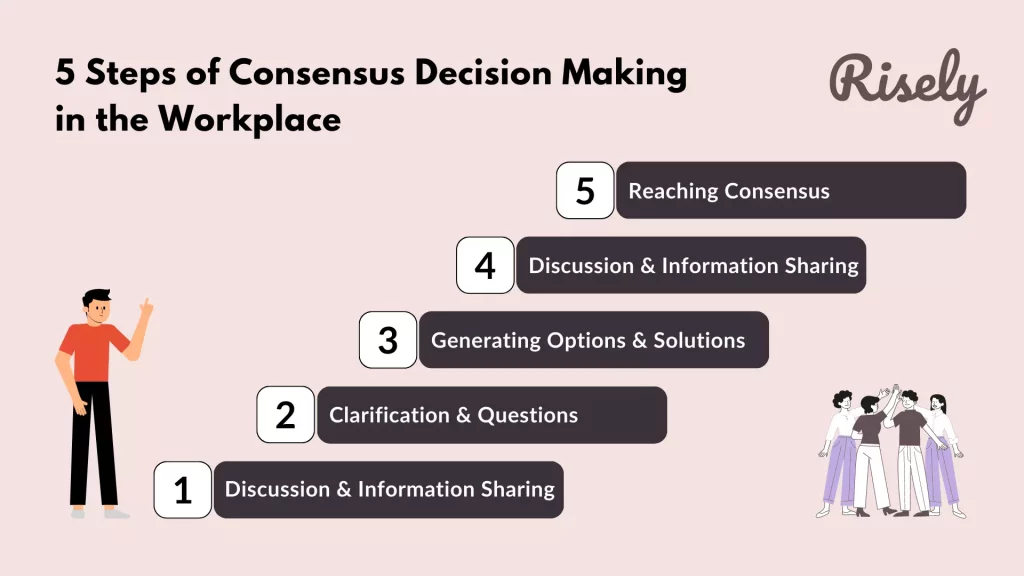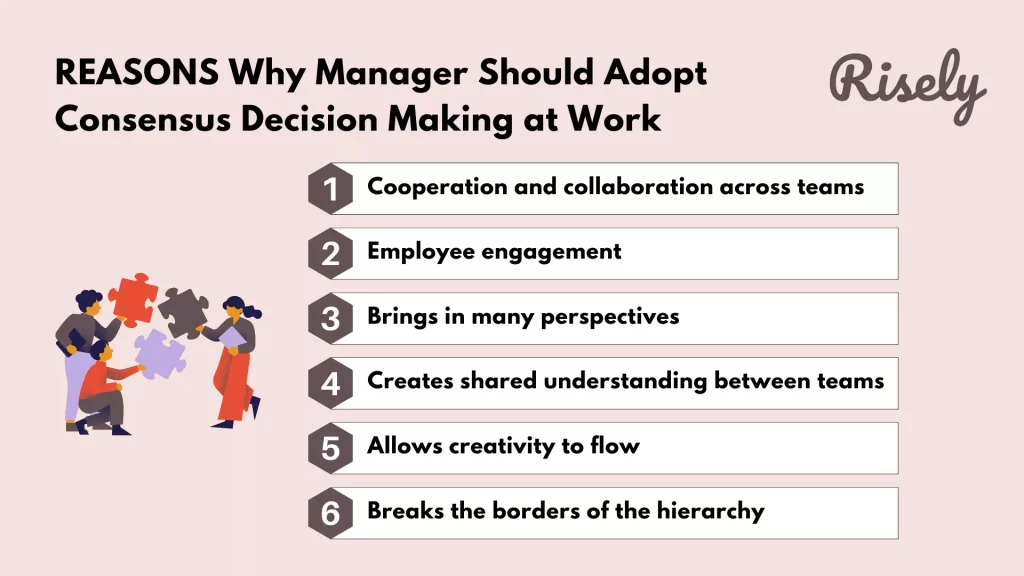Consensus Decision Making: How To Use It At Work
How do decision-making processes at work differ from those in the family? In the office, everyone wants a say in decisions, and opinions are often divided. And while some are happy with the final decision, others feel it’s not the best. Enter consensus decision making — a decision-making process that involves multiple stakeholders to arrive at a collective decision. It is an excellent way of bringing together various perspectives and reaching a consensus. While supporting your team’s decision-making process, you also have to stay satisfied with the end product. Read on to learn how managers can use consensus decision making in their offices and get numerous benefits out of it.What is the consensus decision making style?
The consensus decision making style is a method of reaching an agreement between all members of a team on a particular issue. It differs from majority decision making, such as that used in democratic elections, as it seeks solutions that everyone can agree upon. It is a process in which a group makes its decisions via a collaborative effort that takes into account the best interests of all parties involved. The use of consensus decision making has been observed in many political and social organizations. It has benefits in the workplace too. These groups use this method to reach a consensus without getting into arguments or debates. As a result, participants can have diverse opinions and viewpoints, leading to more creative ideas and solutions being identified. The process also helps participants become more comfortable with each other and build rapport, enhancing communication and strengthening relationships. In addition, this approach can help groups come together and work toward a common goal with less conflict and disagreement.5 Steps of Consensus Decision Making in the Workplace

- Discussion and Information Sharing: During this step, the team gathers to openly discuss the decision that needs to be made. Relevant background information is presented to ensure that everyone has a clear understanding of the issue. Team members share their perspectives, experiences, and concerns related to the decision, creating an open dialogue that sets the stage for collaborative decision-making.
- Clarification and Questions: This step focuses on addressing any confusion or uncertainties about the decision. Participants are encouraged to ask questions to gain a comprehensive understanding of the situation. By clarifying details and providing additional information, the team ensures that everyone is on the same page before moving forward.
- Generating Options and Solutions: Brainstorming is key in this step, where team members collectively generate a variety of potential options and solutions to address the issue. The goal is to encourage creative thinking and diverse viewpoints. Every idea is considered, fostering an environment where individuals feel comfortable contributing their thoughts without fear of criticism.
- Discussion and Evaluation: During this phase, the team discusses the pros and cons of each proposed option. Participants evaluate the feasibility, advantages, disadvantages, and alignment of each option with the team’s goals. Active listening and respectful dialogue are crucial, as team members exchange opinions, insights, and concerns to thoroughly evaluate the alternatives.
- Reaching Consensus: In the final step, the team works toward a decision that everyone can agree upon. Common ground is identified, and concerns are addressed through compromise and collaboration. The emphasis is on finding a solution that respects the values and objectives of the team, while ensuring that each member can endorse the decision with a sense of ownership at work.
3 Consensus Decision Making Examples in the Workplace
Choosing a New Software System
In a technology company, the IT department must choose a new software system to streamline internal processes. The team includes software developers, IT specialists, and project managers. To make the decision using consensus, they:- Discuss the software options, considering ease of integration, cost, and user-friendliness.
- Each team member presents their viewpoints and any concerns they have.
- They brainstorm ways to address concerns, such as investing in training for a complex system.
- Based on feedback, the team narrows down the options and gradually reaches a consensus on the software that best meets their needs.
- Once consensus is reached, they purchase and implement the chosen software, with each member committed to making the transition successful.
Selecting a Team Lead for a Project
A new project is on the horizon in a marketing agency, and the team needs to select a lead. The team comprises designers, copywriters, social media managers, and analysts. To decide on the project lead using consensus, they:- Discuss the strengths and expertise of each team member, considering who would be the best fit for leading the project.
- Share thoughts on how different team members have handled similar responsibilities.
- Address concerns about workload and time commitments by suggesting ways to distribute responsibilities.
- Through open discussions and rounds of feedback, they agree on the team member with the most suitable skills and availability to lead the project.
- The chosen lead accepts the role, understanding the collective decision and their team’s support.
Planning the Company Retreat
The HR department is responsible for planning the annual company retreat in a corporate setting. The HR team includes HR managers, event planners, and administrative staff. To decide on the retreat’s theme and activities using consensus, they:- Brainstorm ideas for the retreat, including potential themes, locations, and activities.
- Share personal preferences and previous retreat experiences to guide the discussion.
- Address concerns about budget constraints and time availability by exploring creative solutions.
- Narrow down the choices based on feedback, finding options that align with the team’s interests and constraints.
- Reach a consensus on the retreat theme and activities that best suit the team’s preferences and goals.
- Proceed with planning the retreat, knowing that the decision reflects the collective input and agreement of the HR team.
Other Interesting Reads
Why should managers adopt consensus decision making?

Cooperation and collaboration across teams
Consensus decision-making is a process that encourages collaboration and joint decision-making among team members. It involves thoroughly discussing the options available, weighing their benefits and drawbacks, and reaching a decision that addresses all concerns. This process helps create an environment of critical dialogue between participants and their peers, which can lead to faster decision making and better results. By adopting consensus decision-making, teams can work together more effectively and reach decisions with incredible speed and efficiency. In addition to helping teams reach decisions quickly, consensus decision-making fosters a sense of ownership and understanding of the decision making process. By engaging in a thorough discussion about the options available, participants develop a deeper understanding of the issues at hand, which can help them make better decisions in the future. Additionally, consensus decision-making encourages participants to engage in a dialogue with their peers, leading to better outcomes if all concerned parties are aware of their perspectives on the matter.Employee engagement
As a manager, consensus decision-making can help engage employees and create a culture of collaboration and shared understanding. In consensus decision-making, team members are encouraged to take ownership of decisions and be more involved in their work. It creates an equalized power environment, enabling employees to take risks and be creative in their work. Additionally, consensus decision-making can lead to better decisions that represent the larger community and create a more effective implementation of plans. Finally, by engaging in consensus decision-making at work, managers can foster a culture of collaboration and promote a sense of shared responsibility within their team.Brings in many perspectives
Consensus decision making is an alternative to “top-down” decision making, allowing all stakeholders to participate in the deliberation process, as opposed to just the group leaders. Consensus decision making provides a scaffold for critical dialogue between all members of the team. Rather than debate individual points of view, consensus decision making aims to go further by weaving together everyone’s best ideas and key concerns, often resulting in creative solutions. In consensus decision making, all group members develop and agree to support a decision in the best interest of the whole. This process enables groups to make better decisions that consider the needs and concerns of all stakeholders.Creates shared understanding between teams
Consensus decision making involves all members of a team engaging in a collaborative process to reach a decision that everyone can agree on. This process creates a shared understanding among the team members, such as students and authors, and encourages critical thinking of all participants. Using consensus decision making can help teams come to a decision that is well-aligned with the group’s goals and mission. Consensus decision making also takes into account various perspectives and concerns of the participants, which helps teams reach a decision that best suits their needs. By reaching a consensus when making decisions, teams can effectively work together towards common goals. Consensus decision making is an essential factor of successful teamwork, as it helps generate a shared vision and foster communication and coordination between teams. It is vital for them to be able to reach a decision together, as this shows they are working together towards a common goal.Allows creativity to flow
Consensus decision making allows teams to engage in a rigorous and creative process of decision-making. Consensus decision making helps teams discuss issues, develop ideas, and reach decisions, allowing the exploration of innovative solutions. With consensus decision making, teams can openly explore all options and challenges that come with a particular proposal or decision. Before moving forward, the group must reach a common understanding of the decision and its implications. Consensus decision making also encourages engagement among team members, as they are given more autonomy in their work and can use creativity to generate solutions. By engaging in this decision-making process, teams can better achieve their goals and the best possible solution for the group.Breaks the borders of the hierarchy
Consensus decision making allows for a collective decision that is better than any individual decision. This process reduces the chance of conflict and promotes collaboration among team members, allowing them to voice their opinions without being biased by the leadership. Additionally, consensus decision making can improve communication and build trust between team members, as all participants are involved in the decision-making process. Ultimately, consensus decision-making can lead to better decisions as it considers all participants’ opinions. Therefore, managers need to adopt this process in order to ensure effective and efficient decision-making within their teams.Conclusion
It is important to understand that consensus decision-making is a process, not an event. It is a way of working that allows everyone to make decisions in a group setting. Through this process, individual viewpoints are valued, and conflict is minimized. It ensures that disagreement does not prevent the group from reaching decisions. However, consensus decision-making requires time and practice to succeed. If you want to adopt a new way of working, start by learning the basics and then move on to more complex ones, such as consensus decision-making. By doing so, your team will be able to work efficiently and better understand one another.How you take decisions – alone or together?
Reflect more on critical decision-making skills with the free self-assessment from Risely
FAQs
How does consensus decision making work?
Consensus decision-making involves open discussions, brainstorming options, addressing concerns, and collaborating until all participants reach an agreement that satisfies everyone’s input and concerns.
What are the principles of consensus in decision making?
Principles of consensus decision-making include active participation, open communication, shared understanding, seeking common ground, addressing concerns, and ensuring that all participants support the final decision.
What are the examples of consensus in the workplace?
Examples of consensus in the workplace include choosing project directions, selecting team leaders, and planning events through open discussions, compromise, and agreement that reflects collective input and support.
Other Related Blogs
10 Signs You’re Struggling with Analysis Paralysis at Work
10 Signs You’re Struggling with Analysis Paralysis at Work The smart fox declares, “I have a hundred ways to escape when trouble approaches. You have only one.” As the dogs…
Evidence Based Decision Making: 4 Proven Hacks For Managers
Evidence Based Decision Making: 4 Proven Hacks For Managers In this blog, we will explore the concept of evidence-based decision-making and provide seven proven hacks for managers to implement evidence-based…
6 Best Books On Decision Making For Managers
6 Best Books On Decision Making For Managers Effective decision-making is crucial for managers to navigate the complexities of their roles. You are responsible for making important choices that can…
Best Decision Coaches To Guide You Toward Great Choices
Best Decision Coaches To Guide You Toward Great Choices Effective decision-making is more crucial than ever in today’s rapidly evolving business landscape. Entrepreneurs, leaders, and professionals alike are constantly faced…


